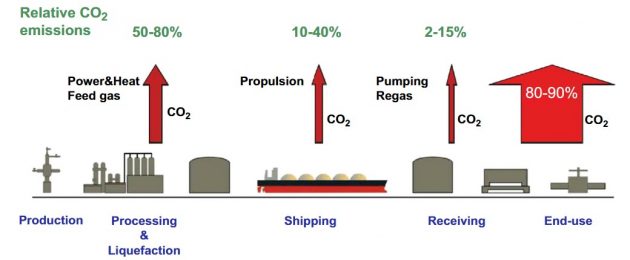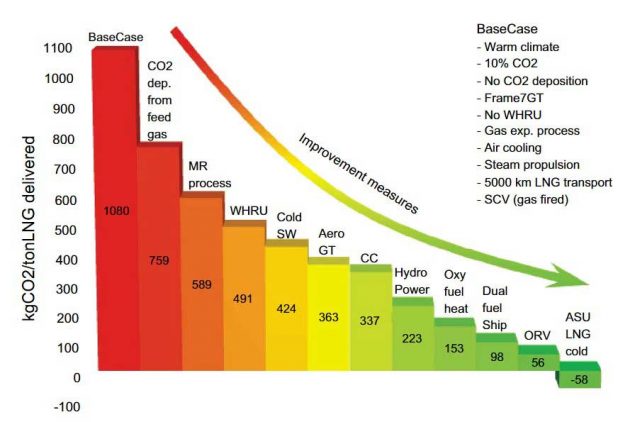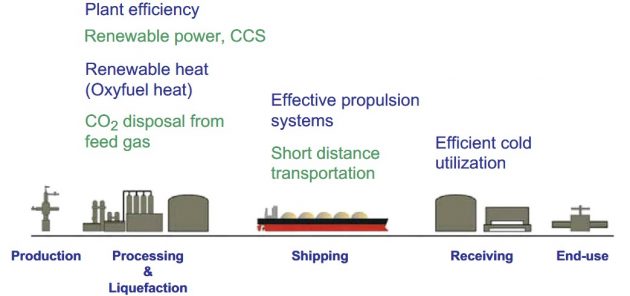LNG is the cleanest fuel in modern world. But peoples should not forget Environment aspects in gas production, to reduce harmful impact on nature.
- Emission sources
- Feed gas conditioning
- Liquefaction
- Transport
- Regasification
- Near zero CO2 emission
- Environmental impacts
- Site selection
- LNG handling hazard and risks
- LNG spill
- Process heating and cooling
- Waste water streams
- Air emissions
- Venting and flaring
- Boil-off gas management
- Fugitive emissions
- Noises
- LNG transport
LNG production has the potential to reduce or eliminate the need for the wasteful process of flaring (burning off) of associated natural gas in oil fields and the resulting environmental impacts. Import LNG can be vaporized to produce natural gas, which can be used in the high efficiency combined cycle power plants to replace coal. Alternatively, LNG can be used as:
- a transportation fuel;
- replacing import oil;
- and is a cleaner fuel.
In effect, LNG production has recovered a low carbon fuel to displace the high carbon oil and coal, and contribute significantly in reducing the environmental impacts.
Despite this positive outcome, LNG plant construction and plant operation may produce pollutions and effluent, which can be an environmental concern if not properly addressed in the project execution, plant design, and operation.
LNG plants have vapor emissions from different sources (i.e., process vents and driver exhausts), liquid effluents from sumps and drains and cooling medium return, and solid waste from spent molecular sieve and mercury removal catalyst. Other major environmental contributions are construction impacts, emissions from sour gases, and stack emissions from fired equipment. Each of these potential contaminants might require different mitigation methods in different jurisdictions around the globe.
A typical LNG liquefaction terminal exporting 4,5 million tonnes of LNG can be expected to produce in the order of 1,2 million tonnes equivalent carbon dioxide of direct emissions. About 10 % of the fuel value in LNG is consumed in the production of LNG. If fuel gas is used to regasify LNG using submerged combustion vaporizers, the greenhouse gas emissions are increased by an equivalent of combusting about 1,5 % of the import LNG, or about 0,2 million tonnes of carbon dioxide emissions.
The designs of the LNG facilities are no different than other hydrocarbon processing plants. Emissions must comply with local and federal environmental regulations. Environmental impact assessment must be completed; emissions must be estimated, starting from the well head to the consumers. In the United States, the Federal Energy Regulatory Commission (FERC) and US Coast Guard must be involved in the permitting processes. The environmental impact statement is part of the overall safety and security assessment.
Emission sources
From an emissions viewpoint, an LNG plant is relatively clean when compared to refineries or petrochemical plants. Some of the major sources of emissions from the different units within the LNG supply chain can be summarized as follows.
Feed gas conditioning
- Condensate Stabilization Unit – waste water and hydrocarbons.
- Glycol Regeneration – chemical waste, hydrocarbons, and waste water.
- Acid Gas Removal Unit – mercury, solvent waste, and waste water.
- Dehydration – mercury, spent mole sieve waste, and waste water.
- NGL Recovery Unit – not significant.
- Sulfur Recovery, Tail Gas Unit, and Incineration – CO2, SOx, H2S, and NOx emissions, and spent catalysts.
- Refrigeration Units – CO2, SOx, H2S, NOx emissions, and particulate matters from gas turbine drivers.
- Power Generation – CO2, SOx, H2S, NOx emissions, and particulate matters from gas turbine drivers, waste water, chemical waste.
Liquefaction
- CO2, SOx, H2S, NOx emissions, and particulate matters from the exhaust stacks from gas turbine drivers, a major contributor of CO2 emissions.
- Increase cooling water and ambient air temperatures.
Transport
- CO2, SOx, NOx emissions, and particulate matters from LNG carriers propulsion engine drives.
- Boil-off gas emissions.
Regasification
- CO2, SOx, and NOx emissions from submerged combustion vaporizers.
- Cold seawater return.
- Fog generation if ambient air vaporizers are used for LNG heating.
The distribution of CO2 emissions for the LNG supply chain, from the well head production, gas processing, and natural gas liquefaction; LNG shipping to the receiving terminals; and regasification is shown in Picture 1. As can be seen, the majority of the CO2 emissions is from the gas processing and liquefaction step, following by LNG shipping and the LNG regasification.

Although these emissions can be minimized through new technologies and innovation, emissions from combustion of natural gas contributes to 80 to 90 % of the emissions. CO2 emissions from the end users can only be reduced through energy conservation.
Near zero CO2 emission
Picture 2 shows the potential improvement in terms of kg of CO2 per ton of LNG delivered for the various technologies. The base case technologies for a typical LNG supply chain consist of the following:
- The liquefaction plant is located in a warm climate area processing feed gas containing 10 mole % CO2. CO2 from the gas treating unit is vented to the atmosphere.
- The liquefaction drivers are based on the simple cycle Frame 7 gas turbine.
- There is no waste heat recovery.
- The air cooler is used for the refrigeration units.
- Ship propulsion uses steam turbine drivers. It is assumed 5 000 km LNG transportation distance using a conventional LNG carrier.
- The regasification terminal uses fuel gas for heating the LNG.
The improvement of natural gas delivered to the consumer results in lower CO2 emissions by employing updated technologies, such as CO2 reinjection for sequestration, more efficient mixed refrigeration liquefaction cycle, waste heat recovery, cold seawater for cooling, more efficient aeroderivative gas turbines, and combined cycle power plant. The use of ORV instead of SCV can save 15 % of the natural gas fuel. If LNG cold is used for air separation, the energy efficiency will be further improved (see Chapter 10).

In summary, CO2 emissions from the LNG supply chain can be significantly reduced with the best available technologies as follows:
- Improved plant efficiency on liquefaction cycles and equipment.
- CO2 reinjection from the amine unit for sequestration.
- More efficient power plant for ship propulsion.
- Utilization of LNG cold in the receiving terminals.
If the distance for transportation is short and there is renewable energy such as hydroelectric power or solar available, CO2 emissions can be further reduced. In short, a zero emission LNG supply chain is possible, as shown in Picture 3.

Environmental impacts
The environmental impacts associated with LNG facilities are project specific. On the liquefaction side, it depends on the feed gas compositions and acid gas contents. High acid gas content feed gas would generate higher sulfur oxides and carbon dioxide emissions. On the regasification side, the location of the terminal determines the source of heating used for LNG vaporization. A cold climate regasification terminal would require submerged combustion vaporizers, which would generate more emissions than a warm climate location where seawater is available.
However, there are impacts on marine life from the cold water discharge from an LNG plant. There are other impacts and risks that must be assessed for the LNG facilities in determining its overall environmental impact. Some of the environmental impacts, potential hazards, and design considerations to reduce the impacts are discussed in the following section.
Site selection
LNG plants, regasification plants, and associated terminal facilities should be located at sites that minimize the effects of natural hazards, and measures should be adopted to provide for the safe operation of LNG vessels at the terminal.
LNG plants, regasification plants, and terminal facilities should be located, designed, constructed, and operated to minimize the risk to the project from natural hazards such as :
- earthquakes;
- tidal waves;
- floods;
- and fires from surrounding areas.
Exclusion zones should be established to minimize the potential hazards of the project to immediate areas from the results of accidents. Site selection should minimize the project’s impact on sensitive ecosystems such as:
- sea life;
- corals;
- fisheries;
- and resources that support local communities.
A site should be selected that can comply with National Fire Protection Association LNG Standards or equivalent standards. Terminal operating procedures, security measures, and emergency response plants must comply with the best industry practice and international guidelines, such as the World Bank Group (1999) Operational Policies and guidelines set forth in the Pollution Prevention and Abatement Handbook.
The construction activities also have significant impact on sea life and the surroundings. Construction; dredging; construction of piers, wharves, breakwaters, and other water-side structures; and soil erosion may lead to long-term impacts on sea life and shoreline habitats. Construction debris, soil sediment, and wastewater discharges may deteriorate water quality in the nearby communities.
LNG handling hazard and risks
Storage, transfer, and transport of LNG may have leaks and accidental vapor releases. Misoperation during storage, unloading, and loading of LNG may pose a fire hazard. To manage such risks, LNG storage tanks, piping systems, and instrumentation must be designed to comply with international safety standards to prevent fires and explosion hazards. The design must handle the different operating modes, from holding operation to LNG unloading operation, from startup to shutdown, as well as natural and climate hazards. The hazard risk can be minimized by design provisions such as storage tank overfill protection, secondary storage containment, and boil-off gas management control. Periodic inspection and maintenance programs must be established.
Loading and unloading of LNG cargoes must be carried out by licensed and well-trained personnel. The procedure should include all phases of the LNG delivery, loading and unloading the LNG, connect and disconnect of the unloading arms or hoses, and strict enforcement of a no-smoking policy for any personnel.
LNG spill
LNG is a cryogenic liquid that is not flammable in liquid form. However, an LNG spill produces boil-off gas as it is vaporized by contact with surfaces, and under the right conditions, the boil-off gas can form a vapor cloud that could result in jet fires or pool fires if an ignition source is present. Details on the hazards and handling of an LNG spill are discussed in Chapter 9.
Measures to prevent LNG spills include the following:
- Conduct a spill risk assessment of the process flow diagram, particularly on vessels with a significant liquid inventory and piping system. The impacts of a potential spill during operations such as during LNG ship loading and unloading should be analyzed.
- Develop a spill prevention and containment plan for spill scenarios and assess the magnitude of vapor releases. A spill control response plan should be developed in coordination with local regulatory agencies.
- Facilities should be equipped with hydrocarbon detection systems to monitor gas leakages.
- An ESD system should be configured to initiate automatic shutdown of the LNG transfer system in case of emergency.
- For unloading/loading of LNG, proper procedure should be stressed to safely purge and drain the liquid inventory prior to disconnect.
- Onshore LNG storage tanks should be designed with secondary containment, such as the use of a full containment tank.
- Impound areas should be designed to contain a credible spill resulting from breakage of outlet piping from vessels and equipment.
- Impound areas should be ventilated to minimize gas accumulation.
- The facility drainage system should be designed to contain the spill and to reduce fire and explosion risk.
Process heating and cooling
In the design of the natural gas liquefaction cycle, air coolers should be used as much as possible instead of cooling water in order to minimize water consumption of the facility.
In LNG regasification terminals where seawater is used for LNG heating, cold water should be discharged to the ocean body in a location that will allow maximum mixing and cooling of the thermal plume. The cold water discharge must be within 3 °C of surrounding water at the edge of the mixing zone or within 100 meters of the discharge point, as noted in the International Finance Corporation (IFC) guideline.
If biocides or chemicals are used, chemical additives must be selected considering:
- dose concentration;
- toxicity;
- biodegradability;
- bioavailability;
- and bioaccumulation potential.
The residual effects of these chemicals on marine life must be carefully evaluated.
Waste water streams
Nonhazardous and hazardous wastes include general wastes such as waste oils, hydraulic fluids, waste chemicals, filter elements, solvent wastes, spent molecular sieves, and spent catalysts and chemicals. These chemicals and solid waste must be properly disposed of or recycled. Efforts should be made to recycle and reclaim the waste materials where possible. If recycling is not practical, wastes must be disposed of in an environmentally safe manner using the best technologies and practices, which must also comply with local laws and regulations.
Air emissions
Air emissions in LNG facilities are mainly from the exhaust stacks from the gas turbines in refrigeration units, utility steam boilers, and gas turbines in power plants. Maximum emissions from the equipment must be specified in the duty specifications of the rotating equipment.
In the regasification terminals, the selection of LNG heaters must consider the difference in emissions and flexibility among a variety of heat exchange equipment; for example, submerged combustion vaporizers (SCV), open rack vaporizers (ORV), shell and tube vaporizers, and ambient air vaporizers. If waste heat is available nearby, such as hot water discharge from a power plant, they should be considered as a heat source for LNG regasification to reduce the overall environmental impact.
Venting and flaring
Flaring or venting is necessary to avoid build-up of excess gas in the system and to safely dispose of the excess gas in the event of an emergency, such as system shutdown, or other plant upset conditions. Every effort should be made to avoid venting and flaring during normal operation by recovering the excess gas as fuel gas.
Boil-off gas management
In the liquefaction plant, boil-off from storage tanks is compressed to the gas turbines inlet, to be used as fuel gas or reliquefied in the process. In the regasification terminal, BOG from storage tanks is compressed by a BOG compressor and recondensed in a BOG recondenser using a portion of the cold LNG sendout. No BOG venting is allowed during normal operation.
Fugitive emissions
Fugitive emissions generally originate from:
- vents;
- leakage from instruments;
- valve packing;
- seals;
- and pressure relief valves.
Equipment and instruments should be designed to meet the emission requirements according to local industrial standards.
Noises
The main noise generation sources in LNG facilities are:
- pumps;
- compressors;
- generators;
- drivers;
- fin fan air coolers;
- LNG vaporizers;
- and heaters.
Installation of noise-dampening devices should be usedwhere necessary.
LNG transport
Emissions from tugs and LNG carriers, especially where the jetty is close to local communities, are a significant emission source that may impact the surrounding air quality. Air emissions from LNG vessels during its period at port must be evaluated for compliance with the local and state regulatory requirements.
